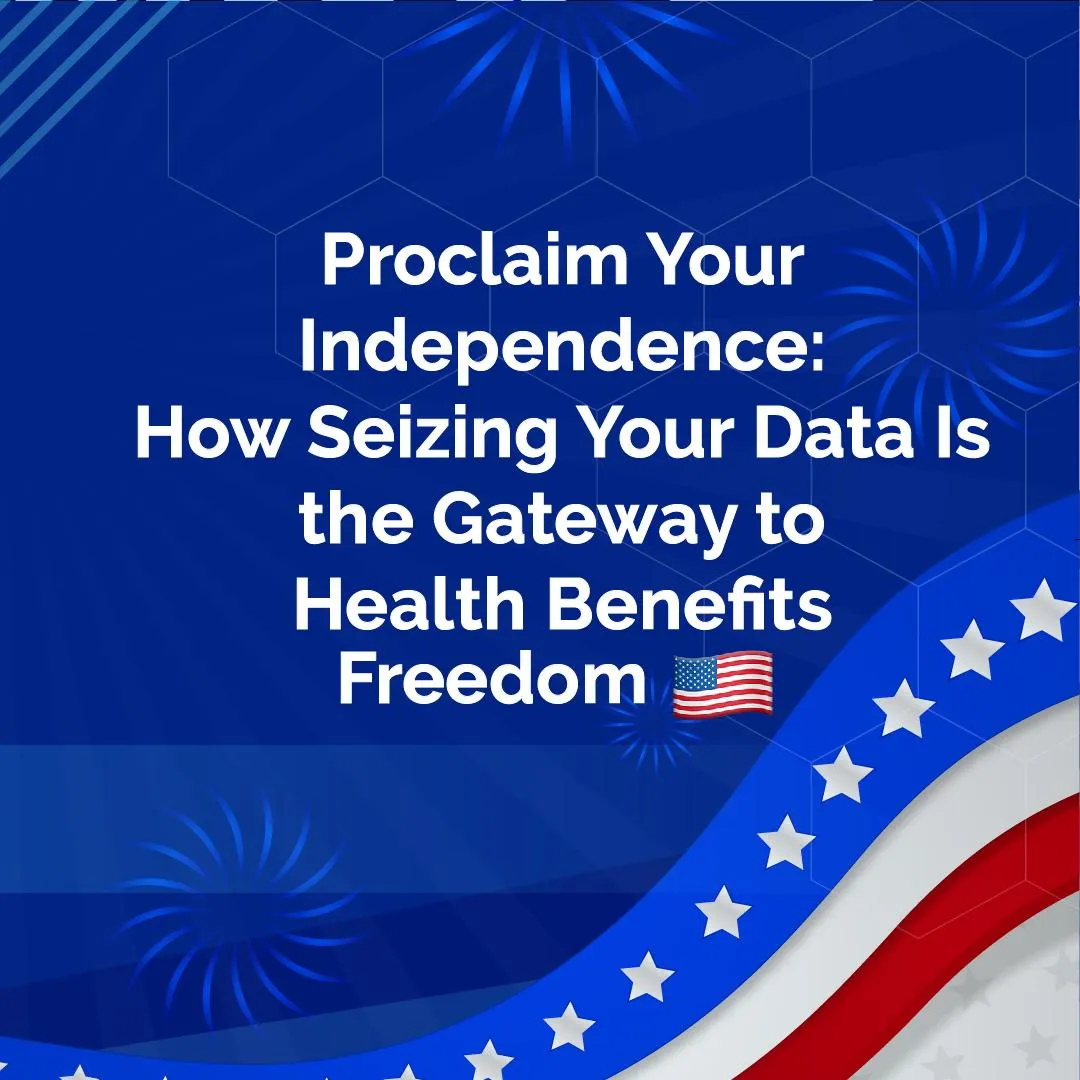WELCOME TO THB BLOG

Proclaim Your Independence: How Seizing Your Data Is the Gateway to Health Benefits Freedom
This month, Americans celebrate independence and freedom — the absence of restrictions and limitations on our ability to pursue our interests without undue reliance on others.
In the health benefits world, the one holding the data enjoys the most freedom.
Employers must proclaim their independence by seizing their data as the foundational first step to exerting their freedom to make informed, quality-boosting, cost-saving decisions that benefit every covered life.
Doing so reduces absenteeism, increases presenteeism, boosts employee morale and loyalty, and attracts top talent.
This month is all about proclaiming independence and seizing health benefits freedom as we dive deep into:
How a data-driven pre-renewal strategy promotes health benefits independence, boosts quality, and drives savings
How data-driven member education promotes and empowers healthcare consumerism
2024 Strategies that dish up the immediate impact
Without access to all the plan data, employers surrender their health plan investment to a third party with a conflict of interest.
1. How a data-driven pre-renewal strategy promotes health benefits independence, boosts quality, and drives savings
Shopping is freedom that dramatically increases the likelihood of the best possible outcomes. We don't have to take what's given — we determine what we need, want, can afford, and the best place to get it. That's independence.

Every time we shop for anything, we use data — except healthcare.
Data shapes every aspect of our lives. We have gobs of it at our disposal.
When you're surfing Amazon for the perfect gadget to dice onions, you have reviews, star ratings, and questions with answers to guide your decision.
When your 16-year-old daughter is ready for her first car, you have Edmunds, CarFax, and safety ratings to make the best choice.
Consumer Reports rates nearly every mattress on the market for comfort and longevity whether you sleep on your back, side, or stomach.
We make countless purchases with price and quality in mind. It's all based on data that's collected and analyzed in a thousand different ways.
We are intentional when we shop.
Organizations shop for office furniture, computers, and software platforms. They review the data on cost, quality, longevity, and performance for nearly every small-ticket purchase they make — why aren't employers as intentional with their big-ticket healthcare spending?
Where's the common sense in that?
Does it ever seem like companies spend more time planning their annual holiday party than they spend on their health benefits plan?
You would never let someone else blindly decide what shoe size you should wear – you get the data by measuring your feet, and then you buy what fits.
One size doesn't fit all, but why would a carrier care about that?
Does a commercial carrier drill into an employer's plan data to customize benefits for the highest quality healthcare at the lowest possible price based on each member group's unique healthcare needs?
No.
Why would they? What's in it for them?
Every year employers hand over their benefits' independence and freedom to insurers beholden to shareholders.
It's a faith-based gesture steeped in the hope that it'll improve next year.
If nothing changes, why would things improve?
Insurance companies are publicly traded entities that must show profits to maintain their shareholders' support. The expense employers call a premium is a revenue on the carrier's income statement.
Premiums are such a colossal part of a carrier's revenue that governmental regulations have required insurers to spend at least 85% of premiums on health insurance claims leaving no more than 15% for administrative costs and profit.1 So, it's basic arithmetic: If carriers only get to keep up to 15 cents of every premium dollar they collect, the only way for them to make more is to raise premiums and the cost of care — not reduce spending.
Organizations entrust one of their top three expenses to an enterprise incented to raise prices annually, allow waste, and overlook rampant inefficiencies because that's where the money is.
Let's distinguish shareholders from stakeholders.
The core problem: The carrier needs to be more motivated to customize a plan to the needs of the member population, eliminate waste and inefficiencies, or execute strategies to save employers healthcare dollars.
So, who is holding the plan data that empowers healthcare consumers, employers, and members, a.k.a. the stakeholders, to make independent, autonomous, informed, cost-saving, quality-driving decisions with freedom?
The carrier has it, and they're committed to showing their shareholders a profit. Saving the customer money doesn't fit into the equation.
The data is in the wrong hands: The one holding the data enjoys the most freedom.

The stakeholders must be the ones shopping for healthcare with the data in hand because they have a vested interest in acquiring the highest quality care at the lowest possible price. The health plan directly affects their personal and financial health.
The data belongs with the stakeholder – not the carrier.
Proclaim healthcare independence – get the data
Employers need to get their data and put it to work. It may be challenging because who gives up a slice of freedom without a fight? In this case, freedom is disguised as cash held close to the chest in a tight, little fist.
Still, nothing worth having is earned without work — you may have to do some prying.
It may not be easy, but it's easier than ever before, thanks to the new Consolidated Appropriations Act of 2021, which requires carriers to supply data to plan sponsors to facilitate greater transparency, promote planning, and illuminate savings opportunities.2 And employers, as the responsible party for prudently spending employee premiums (the fiduciary), are now expected to invest their employees' money based on informed, data-driven decisions.
Healthcare spending has spun out of control. Employers are now required to regain control. The control is in the data.
Once the data is in hand, what do you do with it?
Partner, Pinpoint, and Plan:
Partner with data experts with platforms that analyze the historical utilization data and implement predictive analytics to guide decisions for future programs, services, and restructuring.
Pinpoint the cost drivers. Dive deep into who, what, when, and where members spend the most healthcare dollars.
Create a plan to take action. A benefits team with a skilled adviser, data analytics experts, a properly incented third-party administrator, and a flexible pharmacy benefits manager (PBM) collaborate to identify and execute cost-saving, data-driven strategies. The next step might be direct contracting for primary care and specialty services, or integrating health coaching, mental health services, telehealth, or preventative care programs into the benefits package.
The opportunities to reduce spending while providing high-quality care are in the data – that's where independence and freedom lie.
With the data in hand, it's time to educate members on how and why the highest quality healthcare always comes at the lowest cost. Then, establish incentives that drive high-quality care at a lower price. Finally, celebrate quality and cost-saving wins.
2. How data-driven member education promotes and empowers healthcare consumerism

Educating and motivating members to be savvy healthcare consumers is essential to saving healthcare dollars.
Historically, the thought was that high deductible plans would naturally foster consumerism in members. Unfortunately, that is proven to deter members from getting the healthcare they need due to unaffordable out-of-pocket costs.
To get the care they need from high-quality, lower-cost sources, members need a plan design, education, resources, advocacy, and incentives that supply easy access to consumer-friendly healthcare data.
Members must:
Understand the inverse relationship between cost and quality.
Understand which data is at their disposal and how to access it.
Understand how to connect with advocacy professionals who can help them process and execute an informed decision.
Understand the incentives in place for choosing high-quality, lower-cost healthcare providers.
As employers pinpoint quality and savings opportunities, the implementation plan must include a robust member education and empowerment program to maximize utilization.
Members need to understand the relationship between healthcare cost and quality: when it comes to most purchases, the more we spend, the more quality goes up.
An expensive bottle of wine, a fancy dinner, a flashy car… the old adage, "You get what you pay for" applies most of the time. Healthcare is different — it's the opposite.
This inverse relationship between cost and quality in healthcare is a crucial educational point as a benefits team works to empower members to approach their healthcare as a consumer.
There are several reasons high-cost healthcare leads to lower quality:
Inefficiencies. High-cost healthcare often lacks effective care coordination, which leads to overutilization of services, medical errors, and unnecessary tests, treatments, procedures, and hospitalizations — all of which come with billed charges. These excesses don't improve care, can harm patients, and may lead to additional health issues that should've never occurred in the first place.
Administrative costs. Every visit, procedure, test, surgery, and hospitalization, necessary or unnecessary, requires administrative attention. As medical inefficiencies increase, so do wasted administrative dollars.
Fee-for-service (FFS). FFS models prioritize quantity over quality as this "churn and burn" revenue model only pumps out revenues as more visits, tests, treatments, procedures, surgeries, and hospitalizations are performed. The focus of this model is not higher quality for lower cost — the goal is to do more to earn more. Not a great model when lives are at stake.
In healthcare, quality goes hand-in-hand with lower prices because high-quality healthcare is efficient, value-driven, and encourages independence and freedom.
Incentives like a $0 co-pay for using patient advocacy services and a $0 co-pay for generics motivate members to engage with these savings options.
Lastly, celebrating high-quality, cost-saving wins boosts morale and motivates further healthcare shopping by acknowledging members' contributions to the quality and cost-saving victories without singling out member patients.
3. 2024 Strategies that dish up the immediate impact
Proclaiming independence in health benefits comes with sizable and speedy rewards. These strategies are the low-hanging fruit that's ripe for the taking along the journey to high-quality, lower-cost healthcare freedom.
Transparent drug pricing
Transparent pharmacy claims data often reveals immense cost-saving opportunities hidden in spread pricing. Specifically, the markup a PBM charges the plan over the cost to acquire the medication from the manufacturer or pharmacy can range up to 20 times.
Identifying and eliminating these exorbitant markups dramatically impacts the plan's bottom line.
In addition, the deductibles, co-pays, and co-insurances for high-cost specialty drugs used to treat chronic conditions like cancer, rheumatoid arthritis, and multiple sclerosis can bankrupt a family who needs these medications long-term.
Many families qualify for manufacturer assistance programs (MAP) that provide the drug for free, often bypassing the insurance plan entirely, which benefits the employer and the employee. In other cases, the insurance plan pays the negotiated price for the drug, but the manufacturer waives the patient's out-of-pocket cost.
Either way, the patient gets affordable, high-quality treatment.
Another common method for reducing prescription drug spending is sourcing medication from international, English-speaking countries where drugs are more affordable than in the United States. These drugs are often shipped directly to the patient's home, adding convenience to cost savings.
Location, location, location
Where a member receives care has an immense impact on the cost of the service despite an equal level of quality. An MRI can be performed at two equally high-quality facilities, perhaps only a few miles apart, but one charges $400, and the other charges $3000. Knowing which facilities are high-quality and their prices are vital to sourcing services in the right location to reduce waste.
Likewise, a standard knee replacement can cost upwards of $80,000 at a hospital, while an ambulatory surgery center with the same high-quality care only charges $25,000. Patient advocates paired with financial incentives make a huge difference in steering members to high-quality, lower-cost facilities.
J-Code savings: You're infusing what, where?
Infusion therapy is next-level care via catheter or injection when oral medication can't do the job. A J-code indicates the drug, the dosage, and the mode of delivery.
Naturally, infusion drugs are expensive. However, J-codes are an easy opportunity for immediate savings when you answer these five questions:
Does the patient's condition warrant the use of infusion drugs? Have other lower-cost treatments been tried first?
Is the correct J-code being billed?
Is a volume discount available for commonly prescribed drugs within the member population?
Is the patient a candidate for a biosimilar drug?
Where is the safest setting to administer this drug to the patient at the lowest cost? Infusion drugs administered at a hospital are significantly more expensive than those delivered in the patient's home.
Proclaiming health benefits independence and freedom dramatically impacts the quality of care and the stakeholders' bottom lines. And these strategies can produce results quickly. This is just the start.
Proclaim independence in 2024

Freedom!
Join the battle cry of William Wallace as you soldier toward healthcare independence – a land with freedom of choice where the stakeholders' health and financial well-being are the victory.
Impactful health benefits put the member in the saddle with the right tools, resources, and education, and they attract top talent to the organization as productivity, morale, and company loyalty flourish.
Proclaiming independence and enjoying the freedom to manage one of the employers' costliest expenses effectively requires a pre-renewal strategy founded on data access, analysis, and action. Paired with strategic consumerism and incentives to engage with the health plan, the stakeholders achieve the most advantageous health benefits available.
In the past, plan sponsors endured restrictions and limitations on their ability to pursue their members' interests with undue reliance on the carriers.
No more.
Today, the top-performing employers seize their data, proclaim their independence, and celebrate their healthcare freedom as savvy consumers getting the best quality healthcare at the best prices.
1 http://kff.org/medicare/issue-brief/health-insurer-financial-performance





